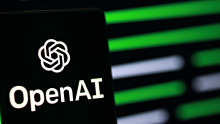ChatGPT4-Questions/User:Darwin2049/Overview
OpenAI - ChatGPT4.
In what follows we attempt to address several basic questions about the onrushing progress with the current focus of artificial intelligence. There are several competing actors in this space. These include OpenAI, DeepMind, Anthropic, and Cohere. A number of other competitors are active in the artificial intelligence market place. But for purposes of brevity and because of the overlap we will limit focus on ChatGPT4 (CG4). Further, we focus on several salient questions that that raise questions of safety, risk and prospects.
Specifically, risks that involve or are:
- Interfacing - Synthesis. how will different groups interact with, respond to and be affected by it; might access modalities available to one group have positive or negative implications for other groups;
how might different groups or actors gain or lose relative advantage; also, how might it be used as a tool of control;
- Evolutionary/Stratification: might new classifications of social categories emerge; were phenotypical bifurcations to emerge would or how would the manifest themselves;
Evolutionary - Synthesis. - Epistemological/Ethical relativism: how to reconcile ethical issues within a society, between societies; more specifically, might it provide solutions or results that are acceptable to the one group but unacceptable to the other group;
Epistemological - Synthesis
Synthesis.
Responding to these questions calls for some baseline information and insights about the issues that this new technology entails. We propose to suggest we look
- Sentiment that has been expressed by knowledgeable observers; a short sampling of sentiment and perceptions include voices that are
- in favor of rapid and forceful development
- expressing caution
- are urging extreme caution going forward;
- pointing to extreme external risks and urging rapid further development;
- Terms, Theory of Operation of technology paradigm used to produce its results;
- concepts are presented that contrast large language models with generative and generative adversarial models;
- several other deep learning models are summarized as well for the purpose of further context;
- LLM operation is sketched out in this section; several helpful video segments are presented that are intended to further facilitate why the LLM approach has become so successful; **novel and unexpected forms of emergent behavior are mentioned;
- Risks our approach has been to present a few commonly occurring risks,
- that are inherent, organic and systemic with any new revolutionary science or technology
- those that arise spontaneously as a result of malicious actors and
- those that are theoretical;
- Insights. If we step back for a moment and summarize what some observers have had to say about this new capability then we might tentatively start with that:
- is based upon and is a refinement of its predecessor, the Chat GPT 3.5 system;
- has been developed using the generative predictive transformer (GPT) model;
- has been trained on a very large data set including textual material that can be found on the internet; unconfirmed rumors suggest that it has been trained on 1 trillion parameters;
- is capable of sustaining conversational interaction using text based input provided by a user;
- can provide contextually relevant and consistent responses;
- can link topics in a chronologically consistent manner and refer back to them in current prompt requests;
- is a Large Language Models that uses prediction as the basis of its actions;
- uses deep learning neural networks and very large training data sets;
- uses a SAAS model; like Google Search, Youtube or Morningstar Financial;
Back to root page: ChatGPT4-Questions
